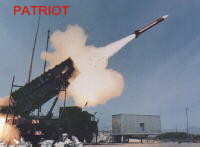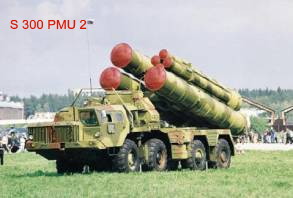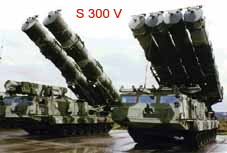INDIA DEFENCE CONSULTANTS
|
WHAT'S HOT? –– ANALYSIS OF RECENT
HAPPENINGS |
|
Protection From Pakistani Missiles
–– An IDC Analysis
|
|
New Delhi, 20
April 2003 Thanks
to the US led war on Iraq, Indian military and DRDO realise the
acute need for setting up an anti-missile system to deter and
withstand the Pakistani ballistic missile threat. Key Indian cities
may be hit by Shaheen series and our vital installations can become
the targets of Pakistani nuclear ballistic missiles with launching
range of 1500 kms. Missile Defence is important since Yashwant Sinha
and George Fernandes and BJP Defence Cell Chief Lt Gen N S Malik
speak of attacking Pakistan, and then retract it in the next breath.
The military has to be ready and they must move ahead just as the
US/UK military was ready for the worst. The excuse “Ministry has
not sanctioned” is not good enough. Our Government is not
Sadam’s government.
DRDO
gave up on the 1993 designed Trishul (the Navy gave up two years
ago) and the Akash could well be obsolete, so a search is on for
anti-missile defences for India post the Iraq war. It is imperative.
India’s deterrence demands that it protect itself from Pakistani
missiles and in due course Chinese missiles, both can be nuclear
tipped. The
Navy has seven older Barak-1 systems with the active guidance AMDR
radar, which are very good and proven by Singapore. The latest
Kashtan SAM (like the Tangushkas) is due to come on the Krivacks.
The Kashmir is on the Delhi class with S-A-N 7s. The older valve
technology Volna Pechora system is on the Rajput, Kashins, the OSA-M
on other ships and the portable IGLA FAM 14 forms the Navy’s
mainstay. This is good planning to cope with the Pakistani Navy’s
Harpoons and other aerial missiles. PN’s surface ORBAT is down
till the Chinese supply the Jeingwei frigates, or Uncle Sam gives
its old Perry class, which India has also asked for, for costing.
The Navy’s new ships Type 17, 15 and ADS on the anvil will need
good gattling guns and a combined anti missile-missile. Americans
Phalanx and Russians Kashtans are on offer. The
IAF have old squadrons of the Pechoras, Iglas and the OSA-AKM
systems while the Army has the OSA-AKM, Tanguskas and Iglas. The
command and control of air defence is not clear between the Army and
the Air Force; and the Strategic Force Commander AM Asthana is
working on this in Vayu Bhavan. ACM Krishnaswamy has stressed for
more coordination of India’s air corridors. Arrow
and Green Pine
The weight of the Arrow-1 was 2,000kg. The new missile, the Arrow-2, weighs 1,300kg, which was first tested in 1995. Arrow-2 successfully acquired, tracked and destroyed TM-91 Arrow missile targets from ranges of 60km and 100km. In February 2003, IAI signed an agreement with Boeing to establish the production infrastructure to manufacture components of the Arrow missile in the US. Boeing is responsible for the production of approximately 50% of the missile components in the US. Boeing will produce various missile components and co-ordinate the production of existing Arrow missile components already being manufactured by more than 150 American companies. IAI will be responsible for integration and final assembly of the missile in Israel. An Arrow battery is equipped with typically four or eight launch trailers, each with six launch tubes and ready-to-fire missiles, a truck mounted Hazelnut Tree Launch Control Centre, a truck mounted communications centre, a trailer mounted Citron Tree fire control centre and the units of a mobile Green Pine radar system. There are microwave and radio data and voice communications Link-16 between the launch centre and the radar command and control centre. The launch system can be located up to 300km from the site selected for the radar command and control centre.
The
two-stage missile is equipped with solid propellant booster and
sustainer rocket motors. The missile uses an initial burn to carry
out a vertical hot launch from the container and a secondary burn to
sustain the missile's trajectory towards the target at a maximum
speed of Mach 9, or 2.5km/s. Thrust vector control is used in the
boost and sustainer phases of flight. At the ignition of the second
stage sustainer motor, the first stage assembly separates. The kill
vehicle section of the missile, containing the warhead, fusing and
the terminal seeker, is equipped with four aerodynamically
controlled moving fins to give low altitude interception capability.
The infrared seeker is an indium antimonite focal plane array
developed by Raytheon (formerly Amber Engineering) and the Raytheon
have the Phalanx with Rolling Missile RAM for the Navy. GREEN PINE EARLY WARNING FIRE CONTROL AND MISSILE GUIDANCE RADAR. The Elta Electronics subsidiary of IAI, which supplies UAVs
The fire control and battle management centre has computer workstations for the Sky Situation Co-ordinator, Intelligence Officer, Post Mission Analysis, Resource Officer and Senior Engagement Officer as well as the Commander's station. The workstations display a large electronic map showing the area of battle. Predicted and confirmed launch sites are colour coded to show priority sites. Link-16, Tadil-J, communications is being developed to allow inter-operability with PEC-2 Patriot fire control units like used in the Iraq war. Assigned targets can be handed over to the Patriot's N/MPQ fire control radar. Tests carried out by the US and Israel have successfully linked the Arrow and US Patriot and also the Arrow and Israeli Defence Force Patriot version. As
distinct from its counterparts the Patriot system does not have own
means for searching and detecting ballistic missiles. In the course
of the war on Iraq, the detection of Scuds was executed by
beyond-the-horizon radar located in Turkey and satellite and JSTARS
reconnoitering system. It is hardly reasonable to connect the
security of India, or any other country for that matter, with the
inclination of Americans. Hence DRDO is groping for solutions. It
should be added that the Arrow along with Patriot were optimized for
destruction of conventional carrier missiles or as a last resort the
chemical warheads. The Pakistani missiles as distinct from the Iraqi
or Iranian ones can be tipped with nuclear warheads, which are less
vulnerable and could be too tough for the Arrow. There is one more
disadvantage of Arrow and this is its “narrow specialization”
because in contrast to its counterparts this system is practically
unable to fight aircraft. The low limit of target engagement zone of
Arrow is 8 kilometers. Therefore it will be necessary to deploy the
additional antiaircraft means for protecting the Arrow positions
against the attack of enemy aircraft. When
analyzing the carriers of air strike means, which the Patriot and
Arrow have to withstand, one can come to the conclusion that these
systems are capable to intercept about 50% of their stock-list.
The
Pakistani ballistic missiles threatening India are very similar to
the onetime American Pershing-2 missiles. For that Russia had
developed the S-300VM (Antey-2500) SAM system. The Pershing-2
missile was equipped with detachable nuclear warhead possessing very
low radar cross-section and fired to 2500 kilometers. The Russian
have created the anti-missile system capable of fighting this threat
effectively. When judged as a target to be intercepted the
Pershing-2 warhead was more sophisticated target than its present
Pakistani counterpart. The
S-300VM is capable of intercepting the low-signature ballistic
warheads with speed of 4500 meters per second and carried by missile
launched from the range of 2500 kilometers. The system has in its
composition the specialized mobile radar capable within three
seconds to detect the warhead and simultaneously to pass the data
for its engagement. The additional advantage of S-300VM system is
its ability to “force out” the enemy jammer aircraft and
airborne command posts from their loitering positions beyond the 200
km limit, which is the engagement range of the SAM system. The
other missile defense means are able to cover about 40% of country
territory from the Shaheen-1 missile or missiles with a shorter
range. But these regions could be exposed to strikes of more
dangerous Shaheen-2 or all types of Ghauri missiles, which can be
intercepted by Antey-2500 SAM system only. Consequently, with the
exception of the Antey-2500 system, there are no other anit-missile
systems capable to protect every target within Indian territory from
Pakistani ballistic missiles with launching range longer than that
of Shaheen-I. Pakistani specialists adhere to the opinion that
missile of Ghauri-2 and Shaheen-2 class is sufficient for ensuring
the security of their country. From this issue the conclusion is
drawn than the declarations about creation of Pakistani missiles
with extended range are mainly of propagandistic character. The
comparison of combat capability of different existing anti-missile
systems proves (With
Inputs from Sayan Mazumdar)
|

 These
were developed by the MLM Division of Israel Aircraft Industries.
The system, codenamed Homa or Fence, was to be deployed in three
batteries including one battery near Tel Aviv and one to the south
of Haifa. The first trial battery became operational in 2000. The US
Strategic Defence Initiative placed a contract on the Electronics
Division of Israel Aircraft Industries to build and test the Chetz-1
(Hebrew name for Arrow 1) Anti Tactical Ballistic Missile (ATBM)
system.
These
were developed by the MLM Division of Israel Aircraft Industries.
The system, codenamed Homa or Fence, was to be deployed in three
batteries including one battery near Tel Aviv and one to the south
of Haifa. The first trial battery became operational in 2000. The US
Strategic Defence Initiative placed a contract on the Electronics
Division of Israel Aircraft Industries to build and test the Chetz-1
(Hebrew name for Arrow 1) Anti Tactical Ballistic Missile (ATBM)
system. and
radars and Pods to India developed the Green Pine early warning and
fire control radar for the Arrow system. The radar EL/M-2090
includes the trailer mounted antenna array, the power generator, a
cooling system and a control centre. Green Pine is an electronically
scanned, solid state, phased array radar operating at L-band in the
range 500MHz to 1,000MHz, and was developed from the Elta Music
phased array radar. Media reported India placed an order for the
supply of two Elta Green Pine for use with India's air defence
system against ballistic missiles. The first parts were delivered in
2001. Tadiran Electronics Limited is the prime contractor for the
Citron Tree battle management / fire control centre. Citron Tree,
which is trailer mounted, downloads the radar data along with data
from other sources and uses powerful signal processing tools to
manage the threat interceptions. The system has man-in-the-loop
intervention capability at every stage.
and
radars and Pods to India developed the Green Pine early warning and
fire control radar for the Arrow system. The radar EL/M-2090
includes the trailer mounted antenna array, the power generator, a
cooling system and a control centre. Green Pine is an electronically
scanned, solid state, phased array radar operating at L-band in the
range 500MHz to 1,000MHz, and was developed from the Elta Music
phased array radar. Media reported India placed an order for the
supply of two Elta Green Pine for use with India's air defence
system against ballistic missiles. The first parts were delivered in
2001. Tadiran Electronics Limited is the prime contractor for the
Citron Tree battle management / fire control centre. Citron Tree,
which is trailer mounted, downloads the radar data along with data
from other sources and uses powerful signal processing tools to
manage the threat interceptions. The system has man-in-the-loop
intervention capability at every stage. 
 that the S-300 VM is a good system capable to ensure
defense not only from all type of aircraft, cruise missiles and
helicopters but it is qualified to intercept to-day and in the near
future all missiles from Pakistan. In case Pakistan increases the
missile launching range over 2500 kilometers its interception will
require the modernization of radars and by then Phalcon / A 50 type
AWACS will be with the IAF. Russians have just disclosed in the
Russian Mirror that they are engaged in development of new S-400 SAM and
C200 long range systems with Don 2 radar. The Director General of
Concern ANTEY Yuri Svirin has declared that the S-300V SAM system is
definitely not the last member of this family.
that the S-300 VM is a good system capable to ensure
defense not only from all type of aircraft, cruise missiles and
helicopters but it is qualified to intercept to-day and in the near
future all missiles from Pakistan. In case Pakistan increases the
missile launching range over 2500 kilometers its interception will
require the modernization of radars and by then Phalcon / A 50 type
AWACS will be with the IAF. Russians have just disclosed in the
Russian Mirror that they are engaged in development of new S-400 SAM and
C200 long range systems with Don 2 radar. The Director General of
Concern ANTEY Yuri Svirin has declared that the S-300V SAM system is
definitely not the last member of this family.